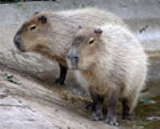
Hydrochoerinae
Encyclopedia
Hydrochoerinae is a subfamily of Caviidae
, consisting of two living genera, Hydrochoerus
, the capybaras, and Kerodon
, the rock cavies. In addition, a number of extinct genera related to capybaras should also be placed in this subfamily. The taxonomy of Hydrochoerinae is confused by the fact that, until recently living capybaras and their extinct relatives were placed in their own family, Hydrochoeridae (e.g. McKenna and Bell, 1997). Recent molecular phylogenetic studies recognize a close relationship between Hydrochoerus and Kerodon (Rowe and Honeycutt, 2002), supporting placement of both genera in a subfamily of Caviidae
(Woods and Kilpatrick, 2005). Paleontological classifications have yet to incorporate this new taxonomy, and continue to use Hydrochoeridae for all capybaras, while using Hydrochoerinae for the living genus and its closest fossil relatives such as Neochoerus
(Vucetich et al., 2005; Deschamps et al., 2007). The taxonomy of fossil hydrochoerines is also in a state of flux. In recent years, the diversity of fossil hydrochoerines has been substantially reduced (Prado et al., 1998; Vucetich et al., 2005; Deschamps et al., 2007). This is largely due to the recognition that capybara molar
teeth show strong variation in shape over the life of an individual (Vucetich et al., 2005). In one instance, material once referred to four genera and seven species on the basis of differences in molar shape is now though to represent differently aged individuals of a single species, Cardiatherium paranense (Vucetich et al., 2005).
Caviidae
The cavy family is a family of rodents native to South America, and including the domestic guinea pig, wild cavies, and the capybara, among other animals...
, consisting of two living genera, Hydrochoerus
Hydrochoerus
The genus Hydrochoerus contains two living species of capybaras from South America and Panama, the largest living rodents in the world. The genus name is derived from the Greek ὕδωρ plus χοίρος ....
, the capybaras, and Kerodon
Kerodon
The genus Kerodon contains two species of South American rock cavies related to capybaras.-Characteristics:Adults weigh about 800 grams. Gestation period is 76–77 days with 1-3 young born to females. Metabolic rate is 0.45 ml-O2/...
, the rock cavies. In addition, a number of extinct genera related to capybaras should also be placed in this subfamily. The taxonomy of Hydrochoerinae is confused by the fact that, until recently living capybaras and their extinct relatives were placed in their own family, Hydrochoeridae (e.g. McKenna and Bell, 1997). Recent molecular phylogenetic studies recognize a close relationship between Hydrochoerus and Kerodon (Rowe and Honeycutt, 2002), supporting placement of both genera in a subfamily of Caviidae
Caviidae
The cavy family is a family of rodents native to South America, and including the domestic guinea pig, wild cavies, and the capybara, among other animals...
(Woods and Kilpatrick, 2005). Paleontological classifications have yet to incorporate this new taxonomy, and continue to use Hydrochoeridae for all capybaras, while using Hydrochoerinae for the living genus and its closest fossil relatives such as Neochoerus
Neochoerus
Neochoerus is an extinct genus of rodent closely related to the living capybara.-References:*...
(Vucetich et al., 2005; Deschamps et al., 2007). The taxonomy of fossil hydrochoerines is also in a state of flux. In recent years, the diversity of fossil hydrochoerines has been substantially reduced (Prado et al., 1998; Vucetich et al., 2005; Deschamps et al., 2007). This is largely due to the recognition that capybara molar
Molar (tooth)
Molars are the rearmost and most complicated kind of tooth in most mammals. In many mammals they grind food; hence the Latin name mola, "millstone"....
teeth show strong variation in shape over the life of an individual (Vucetich et al., 2005). In one instance, material once referred to four genera and seven species on the basis of differences in molar shape is now though to represent differently aged individuals of a single species, Cardiatherium paranense (Vucetich et al., 2005).

